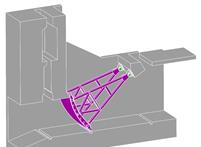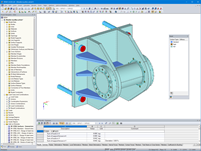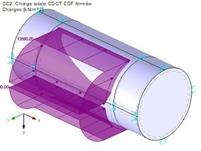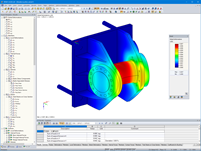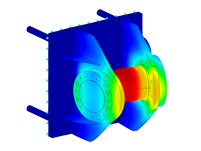A control valve is used to regulate the water flow between the dam’s high and low levels by allowing water to drain from the reservoir. A large single-unit steel element is used.
The complete valve was initially designed by the Moscatelli company, which supplied the 3D trunnion file in STEP format to a Dlubal customer, AGICEA.
Technical Details and Shear Load Determination
Each trunnion consists of a clevis (machine-welded assembly) that includes mixed sintered bronze-graphite alloy guide supports. These supports make it possible to rotate a continuously round 7.87-inch-diameter axis without additional lubrication. The assembly consists of a stainless-steel alloy with strong material properties (high elasticity and rupture limit).
For the trunnion, the hydraulic compression load to be applied to the central axis was determined.
A load of 138.8 t corresponding to the hydraulic shear force generated on one of the two rotating arms was then applied in the FEA structural analysis software (RFEM). The load was converted to a surface force distributed over half the axis area. The total surface shear force calculated was 291,560.6 psf.
Deformation Design
After modeling the mechanical assembly as a solid (3D finite element), AGICEA reviewed the total deformations of each subgroup, including:
• Bronze and graphite supports
• 7.87-inch-diameter central axis
• Clevis
Afterwards, the equivalent stresses (Von Mises) were analyzed to avoid high stress peaks. These values were compared to the allowable material limit values.
Fatigue Design
Fatigue designs according to EN 1993-1-9 were also carried out. AGICEA developed a macro to find maximum stresses automatically (equivalent, tensile, and shear stresses) at locations prone to cracking. The entire trunnion was designed for 438,000 cycles, which corresponds to one movement per hour throughout the year over a period of 50 years.
| Location | Avignon, France |
| Owner | Moscatelli Group, France www.groupe-moscatelli.com |
| Structural Design | AGICEA, France www.agicea-bureau-etudes.fr |








